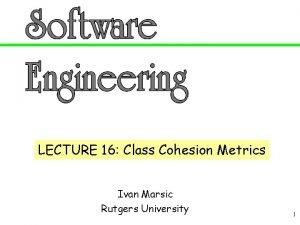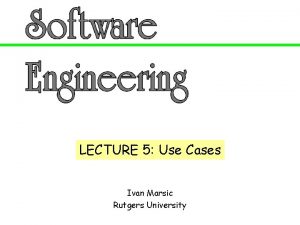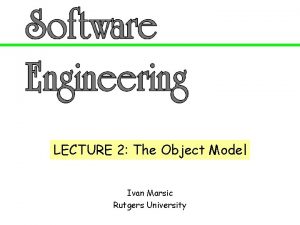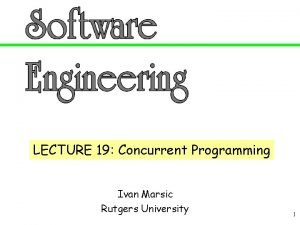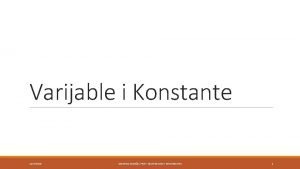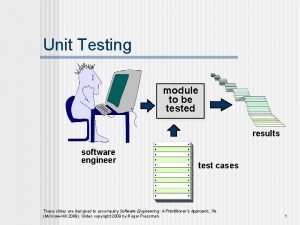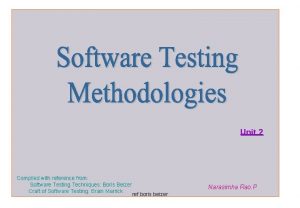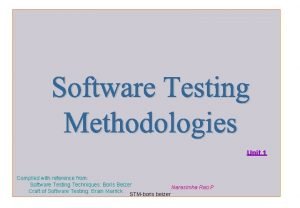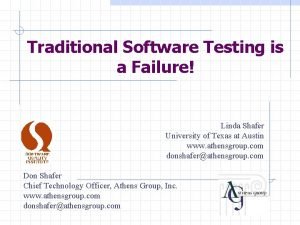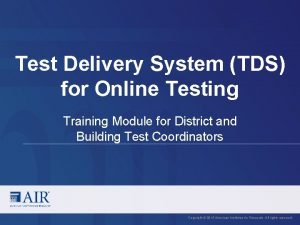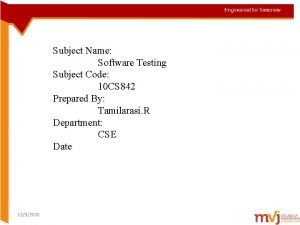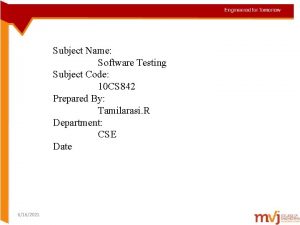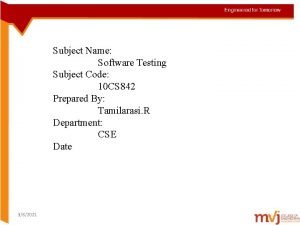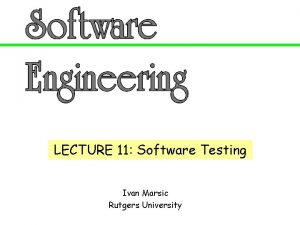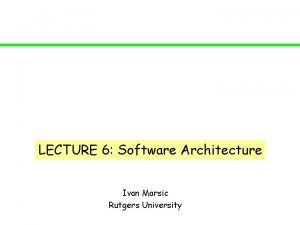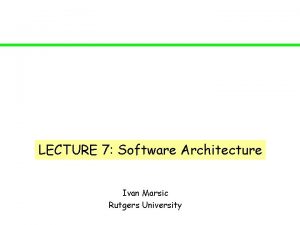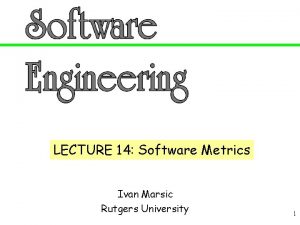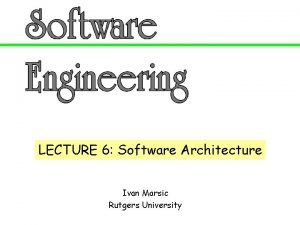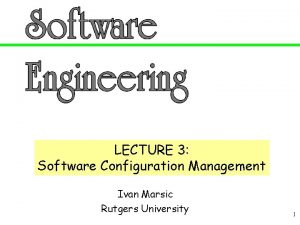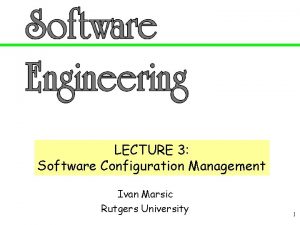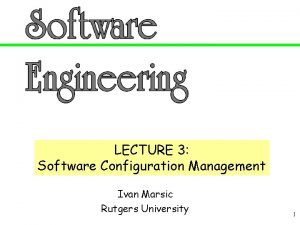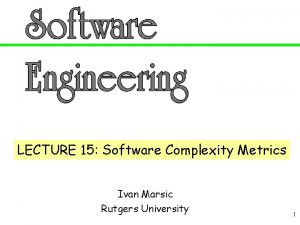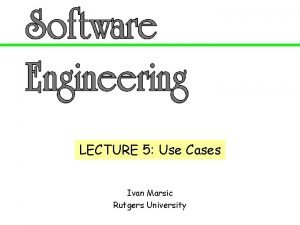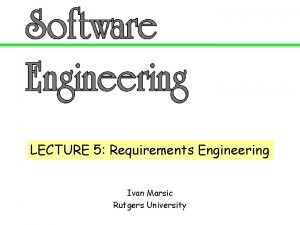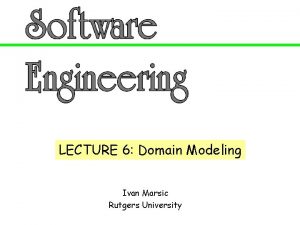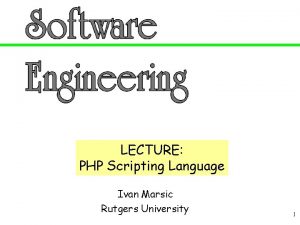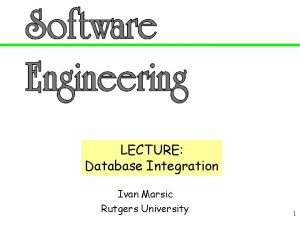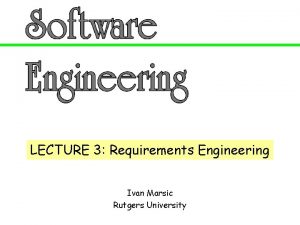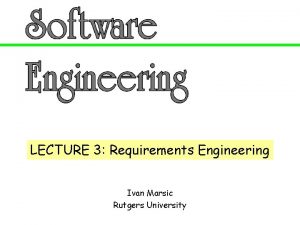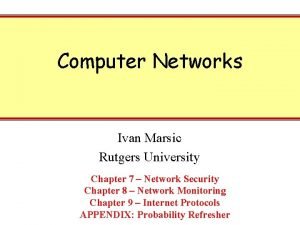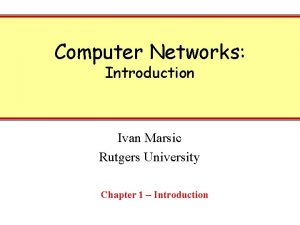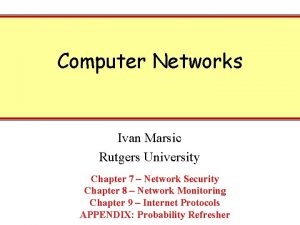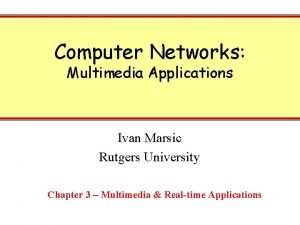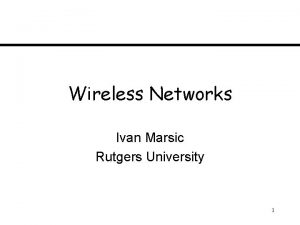LECTURE 11 Software Testing Ivan Marsic Rutgers University



































- Slides: 35

LECTURE 11: Software Testing Ivan Marsic Rutgers University

Topics q Overview of Software Testing 1. Make a plan for systematic testing 2. Write and run tests; test automation q Designing Tests for High Coverage q Practical Aspects of Unit Testing q Integration and System Testing q Security Testing 2

Do I Need to Do Testing? q Everyone who develops software does testing—that’s unavoidable q The only question is whether testing is conducted haphazardly by random trial-and-error, or systematically, with a plan q Why it matters? —The goal is to try as many “critical” input combinations as possible, given the time and resource constraints – i. e. , to achieve as high coverage of the input space as is practical, while testing first the “highest-priority” combinations – Key issue: strategies for identifying the “highest priority” tests 3

Overview of Software Testing q “Testing shows the presence, not the absence of bugs. ” — Edsger W. Dijkstra q A fault, also called “defect” or “bug, ” is an erroneous hardware or software element of a system that can cause the system to fail q Test-Driven Development (TDD) • Every step in the development process must start with a plan of how to verify that the result meets a goal • The developer should not create a software artifact (a system requirement, a UML diagram, or source code) unless they know how it will be tested q A test case is a particular choice of input data to be used in testing a program and the expected output or behavior q A test is a finite collection of test cases White-box testing exploits structure within the program (assumes program code available) Black-box testing explores input space of functionality defined by an interface specification 4

Why Testing is Hard q Any nontrivial system cannot be completely tested – Example: testing 4 -digit numeric keycodes • You never know with certainty that all 4 -digit codes work as expected unless you try all • But, what happens with “incomplete” (3 -digit, 2 -digit) codes? Will all of them timeout to reset state? • Or, will all tuples (pairs, triplets, etc. ) of successive incomplete codes timeout to the reset state? q Our goal is to find faults as cheaply and quickly as possible. – Ideally, we would design a single “right” test case to expose each fault and run it q In practice, we have to run many “unsuccessful” test cases that do not expose any faults q A key tradeoff of testing: – testing as many potential cases as possible (high degree of “test coverage”) while keeping the economic costs limited q Underlying idea of software testing: – the correct behavior on “critical” test cases is representative of correct behavior on untested parts of the state space 5

Logical Organization of Testing ( Usually not done in a linear step-by-step order and completed when the last step is reached! ) Component (unit) code Unit test Te st Unit test ed co White box testing (by developer) m po ne nt Integration test Component (unit) code Unit test Ensure that each component works as specified Black box testing (by customer) Integrated modules System test System in use Ensures that all components work together Function test Verifies that functional requirements are satisfied Quality test Verifies nonfunctional requirements Acceptance test Customer verifies all requirements Installation test Testing in user environment (“platform”) 6

Acceptance Tests – Safe Home Access Examples ( “black box” testing: focus on the external behavior ) [ Recall Section 2. 2: Requirements Engineering ] Input data q Test with the valid key of a current tenant on his/her apartment (pass) Expected result q Test with the valid key of a current tenant on someone else’s apartment (fail) q Test with an invalid key on any apartment (fail) q Test with the key of a removed tenant on his/her previous apartment (fail) q Test with the valid key of a just-added tenant on his/ her apartment (pass) 7

Example: Test Case for Use Case [ Recall Section 2. 3. 3: Detailed Use Case Specification ] Test-case Identifier: TC-1 Use Case Tested: UC-1, main success scenario, and UC-7 Pass/fail Criteria: The test passes if the user enters a key that is contained in the database, with less than a maximum allowed number of unsuccessful attempts Input Data: Numeric keycode, door identifier Test Procedure: Expected Result: Step 1. Type in an incorrect keycode and a valid door identifier System beeps to indicate failure; records unsuccessful attempt in the database; prompts the user to try again Step 2. Type in the correct keycode and door identifier System flashes a green light to indicate success; records successful access in the database; disarms the lock device 8

Test Coverage q Test coverage measures the degree to which the specification or code of a software program has been exercised by tests – “Big picture”: Specification testing focuses on the coverage of the input space, without necessarily testing each part of the software Acceptance tests – “Implementation details”: Code coverage measures the degree to which the elements of the program source code have been tested Unit tests 9

Heuristic: Some Tests are More “Critical” than Others q Test cases should be prioritized—some tests are more likely to uncover faults q Tests are about finding developer errors, and people are prone to make certain kind of errors q Some tests can easier pinpoint problems than others q (some) Heuristics for achieving high coverage: (could be applied individually or in combination) – – equivalence testing boundary testing control-flow testing state-based testing mostly for “black-box” testing mostly for “white-box” testing 10

Input Space Coverage: Equivalence Testing q Equivalence testing is a black-box testing method that divides the space of all possible inputs into equivalence groups such that the program is expected to “behave the same” on each input from the same group • • Assumption: A well-intentioned developer may have made mistakes that affect a whole class of input values Assumption: We do not have any reason to believe that the developer intentionally programmed special behavior for any input combinations that belong to a single class of input values q Two steps: 1. partitioning the values of input parameters into equivalence groups 2. choosing the test input values from each group Equivalence classes: 11

Heuristics for Finding Equivalence Classes q For an input parameter specified over a range of values, e. g. , a number or a letter, partition the value space into one valid and two invalid equivalence classes q For an input parameter specified with a single value, e. g. , a unique “security code, ” partition the value space into one valid and two invalid equivalence classes q For an input parameter specified with a set of values, e. g. , day or month names, partition the value space into one valid and one invalid equivalence class q For an input parameter specified as a Boolean value, partition the value space into one valid and one invalid equivalence class 12

Input Space Coverage: Boundary Testing q Boundary testing is a special case of equivalence testing that focuses on the boundary values of input parameters – Based on the assumption that developers often overlook special cases at the boundary of equivalence classes (e. g. , Microsoft Zune bug: https: //en. m. wikipedia. org/wiki/Leap_year_bug ) q Selects elements from the “edges” of each equivalence class, or “outliers” such as • • zero, min/max values, empty set, empty string, and null confusion between > and >= palindromes (impossible to build an FSM to recognize a palindrome code) etc. 13

Code Coverage: Control-flow Testing q Statement coverage • Each statement executed at least once by some test case q Edge coverage • Every edge (branch) of the control flow is traversed at least once by some test case q Condition coverage • Every condition takes TRUE and FALSE outcomes at least once in some test case q Path coverage • Finds the number of distinct paths through the program to be traversed at least once Constructing the control graph of a program for Edge Coverage: * Exceptions are also a form of control flow, as is concurrency or multithreading 14

Code Coverage: State-based Testing q State-based testing defines a set of abstract states that a software unit (object) can take and tests the unit’s behavior by comparing its actual states to the expected states – This approach is popular with object-oriented systems – Like equivalence classes, state diagrams usually are mind constructs and may be incomplete (not showing all possible states and transitions) or incorrect q The state of an object is defined as a constraint on the values of its attributes – Because the methods use the attributes in computing the object’s behavior, the behavior depends on the object state – An object without attributes does not have states, but still can be unit-tested (shown later) 15

State-based Testing Example (Safe Home Access System) q Define the relevant states as combinations of object attribute values: 1. “Locked” ≡ defined as: (lock. Device. Armed == true) && (num. Of. Attempts == 0) 2. “Accepting” ≡ defined as(*): (lock. Device. Armed == true) && (0 < num. Of. Attempts < max. Num. Of. Attempts) 3. “Unlocked” ≡ defined as: (lock. Device. Armed == false) && (num. Of. Attempts == 0) 4. “Blocked” ≡ defined as: (lock. Device. Armed == true) && (num. Of. Attempts == max. Num. Of. Attempts) 5. “Undefined” ≡ defined as: ((num. Of. Attempts < 0) || (max. Num. Of. Attempts < num. Of. Attempts)) || ((lock. Device. Armed == false) && (num. Of. Attempts != 0)) 1. Define the relevant events: 1. User entered a valid key 2. User entered an invalid key (*) One may argue that “Locked” is a sub-state of “Accepting” … 16

State-based Testing Example event guard condition action state transition 17

State-based Testing Example (counting attempts) 18

Controller State Diagram Elements q Four states { Locked, Unlocked, Accepting, Blocked } q Two events { valid-key, invalid-key } q Five valid transitions { Locked Unlocked, Locked Accepting, Accepting Unlocked, Accepting Blocked } 19

Ensure State Coverage Conditions Ø Cover all identified states at least once (each state is part of at least one test case) Ø Cover all valid transitions at least once Ø Trigger all invalid transitions at least once 20

Practical Aspects of Unit Testing q Mock objects: – A test driver simulates the part of the system that invokes operations on the tested component – A test stub simulates the components that are called by the tested component q Mock objects needed because: – The corresponding actual objects are not available – Easier to locate faults using mock objects that are trivial and therefore not a source of faults q The unit to be tested is also known as the fixture q Unit testing follows this cycle: 1. Create thing to be tested (fixture), the driver, and the stub(s) 2. Have the test driver invoke an operation on the fixture 3. Evaluate that the actual state equals expected state 21

Testing the Key. Checker (Unlock Use Case) (a) (b) 22

Example Test Case Listing 2 -1: Example test case for the Key Checker class. public class Checker. Test { // test case to check that invalid key is rejected @Test public void check. Key_any. State_invalid. Key. Rejected() { // 1. set up // no states defined for Key Checker fixture = new Checker( /* constructor params */ ); // 2. act // test driver (this object) invokes tested object (Key Checker) Key invalid. Test. Key = new Key( /* setup with invalid code */ ); boolean result = fixture. check. Key(invalid. Test. Key); // 3. verify // check assert. Equal(result, false); that invalid key is rejected } } 23

Test Case Method Naming Example test case method name: check. Key_any. State_invalid. Key. Rejected() 24

x. Unit / JUnit q Verification of the expected result is usually done using the assert_*_() methods that define the expected state and report errors if the actual state differs q http: //www. junit. org/ q Examples: – – assert. True(4 == (2 * 2)); assert. Equals(expected, actual); assert. Null(Object object); etc. 25

Another Test Case Example Listing 2 -2: Example test case for the Controller class. public class Controller. Test { // test case to check that the state Blocked is visited @Test public void enter. Key_accepting_to. Blocked() { // 1. set up: bring the fixture to the starting state Controller fixture = new Controller( /* constructor params */ ); // bring Controller to the Accepting state, just before it blocks Key invalid. Test. Key = new Key( /* setup with invalid code */ ); for (i=0; i < fixture. get. Max. Num. Of. Attempts (); i++) { fixture. enter. Key(invalid. Test. Key ); } assert. Equal( // check that the starting state is set up fixture. get. Num. Of. Attempts (), fixture. get. Max. Num. Of. Attempts () – 1 ); // 2. act fixture. enter. Key(invalid. Test. Key ); // 3. verify assert. Equal( // the resulting state must be "Blocked" fixture. get. Num. Of. Attempts (), fixture. get. Max. Num. Of. Attempts () ); assert. Equal(fixture. is. Blocked (), true); } } 26

Integration Testing q Key Issue: – How to assemble individually-tested “units” and quickly locate faults that surface during integration q Horizontal Integration Testing – “Big bang” integration • Problem: hard to isolate individual unit(s) that caused an integration fault – Bottom-up integration – Top-down integration – Sandwich integration q Vertical Integration Testing – Vertically slice the system by use cases and first integrate within each slice (using any of the horizontal integration techniques) 27

Horizontal Integration Testing System hierarchy: Implementation and testing proceeds from Level-1 (bottom) to Level-4 (top) Bottom-up integration testing: Advantages: • only few mock objects need to be implemented Drawbacks: • end user cannot see any functionality until late in the development process Top-down integration testing: Implementation and testing proceeds from Level-4 (top) to Level-1 (bottom) 28

Vertical Integration Testing inner feedback loop outer feedback loop Whole system Developing user stories: Each story is developed in a cycle that integrates unit tests in the inner feedback loop and the acceptance test in the outer feedback loop 29

Logical Organization of Testing ( Not necessarily how it’s actually done! ) Component code Unit test Te st Unit test ed co m po ne nt Integration test Component code Unit test Ensure that each component works as specified Integrated modules System test System in use Ensures that all components work together Function test Verifies that functional requirements are satisfied Quality test Verifies nonfunctional requirements Acceptance test Customer verifies all requirements Installation test Testing in user environment 30

System Testing q To test the whole system in our case study of safe home access, we need to work with a locksmith and electrician to check that the lock and electrical wiring are properly working, or with a third party software developer (if 3 rd party software is used)

Security Honeypots q A deception used to detect and study network attacks – Part of security testing of software systems

Honeypot Access Control Who are the users? q Attackers: – Access the VM set up for them q Researchers – Access the host, the attackers’ VM – Should not erase files by mistake… 33

Honeypot Access Control Matrix Asset Access Control List Role Asset Attacker VM Others Attack’s VM HOST Attacker Deploy, Read, Write None Researcher None Full, with confirmation Role capabilities 34

Honeypot Access Control Who are the users? q Attackers – Script kiddies: 95% • Untrusted • Run malware found on the internet • Easy to protect against – Advanced attackers: 5% • Untrusted • Are able to understand evade the system • Harder to protect against q Researchers Refine the access control for the new distinction! – Trusted – Can erase file by mistake… 35
 Lcom tcc
Lcom tcc Ivan marsic
Ivan marsic Deus ex machina ivan milat
Deus ex machina ivan milat Ivan marsic
Ivan marsic Martina maršić
Martina maršić Domain closure in software testing
Domain closure in software testing Logic based testing
Logic based testing Data flow testing strategies in software testing
Data flow testing strategies in software testing Localization globalization testing
Localization globalization testing What is testing
What is testing Control structure testing in software engineering
Control structure testing in software engineering Decision table testing in software testing
Decision table testing in software testing Decision table for triangle problem
Decision table for triangle problem Decision table based testing in software testing
Decision table based testing in software testing Rigorous testing in software testing
Rigorous testing in software testing Testing blindness in software testing
Testing blindness in software testing Software domain examples
Software domain examples 01:640:244 lecture notes - lecture 15: plat, idah, farad
01:640:244 lecture notes - lecture 15: plat, idah, farad Positive and negative testing
Positive and negative testing Cs3250
Cs3250 Neighborhood integration testing
Neighborhood integration testing Apa yang dimaksud dengan black box testing
Apa yang dimaksud dengan black box testing Black-box testing disebut juga sebagai behavioral testing
Black-box testing disebut juga sebagai behavioral testing Component testing is a black box testing
Component testing is a black box testing Requirement analysis in software engineering notes
Requirement analysis in software engineering notes Lecture notes on project management
Lecture notes on project management Lecture presentation software
Lecture presentation software State graph in software testing
State graph in software testing Module testing in software engineering
Module testing in software engineering Path sensitizing in software testing
Path sensitizing in software testing Consequences of bugs in stm
Consequences of bugs in stm Linda shafer
Linda shafer Test delivery system
Test delivery system Special value testing
Special value testing Software testing subject code
Software testing subject code Software testing subject code
Software testing subject code
